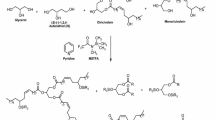Summary
Methods of purifying technical monoglycerides produced from cottonseed oil stearine by interesterification were investigated.
It was found that the concentration of uncombined glycerol in technical monoglycerides could be reduced to about 0.4% by dissolving the technical product in commercial hexane, adding water equivalent to twice the amount of free glycerol, and separating the hexane solution. The formation of stable emulsions was largely avoided by this procedure.
Technical monoglycerides containing 38.9% monoglycerides were purified by distributing them between two immiscible liquid phases (commercial hexane and an aqueous solution of methanol or ethanol). Products containing as much as 80% of monoglycerides were obtained in this manner.
On fractionally crystallizing a solution of the same technical monoglyceride from aqueous ethanol, a glyceride fraction having a purity of 92% and containing 74% of the monoglycerides in the technical product was obtained.
It was found that by addition of proper amounts of water ethanol, isopropanol, methanol, and acetone could be made nearly equivalent for fractionating mixtures of glycerides. Methanol is most sensitive to a change in water content while isopropanol is least sensitive.
When commercial hexane was used in the fractional crystallization of technical monoglycerides, as much as 84% of the non-monoglycerides was retained in the liquid phase, and the glycerides from this phase were found to have a monoglyceride content of 9.8%. The solids obtained by crystallizations from hexane were found to simulate the filtrates obtained with the polar solvents.
When a mixture of technical monoglycerides was partially crystallized from a solvent, the composition of the glycerides remaining in the solvent was relatively unaffected by changes in the concentration of the glycerides originally present in the solution.
Similar content being viewed by others
References
Arrowsmith, C. J., and Ross, J., U. S. Pats. 2,383,580-1 (1945).
Christensen, C. W. (to Armour & Co.), U. S. Pat. 2,022,493 (1935).
Edeler, A., and Richardson, A. S. (to Procter & Gamble Co.), Can. Pats. 340,803-5 (1934).
Feuge, R. O., and Bailey, A. E., Oil & Soap,23, 259–264 (1946).
Grün, A., in Chemie und Technologie der Fette und Fettprodukte, edited by H. Schönfeld; Springer, Vienna, 1936, Vol. I, pp. 276–278.
Handschumacher, H., and Linteris, L., J. Am. Oil Chem. Soc.,24, 143–145 (1947).
Kawai, S., J. Soc. Chem. Ind. Japan, Suppl. Bind.,43, 220–221B (1940).
Ross, J., Bell, A. C., Arrowsmith, C. J., and Gebhart, A. I., Oil & Soap,23, 257–259 (1946).
Weaver, E. R., J. Am. Chem. Soc.,36, 2462–2468 (1914).
Author information
Authors and Affiliations
Additional information
One of the laboratories of the Bureau of Agricultural and Industrial Chemistry, Agricultural Research Administration, U. S. Department of Agriculture.
About this article
Cite this article
Feuge, R.O., Gros, A.T. Modification of vegetable oils. IX. Purification of technical monoglycerides. J Am Oil Chem Soc 27, 117–122 (1950). https://doi.org/10.1007/BF02634379
Received:
Issue Date:
DOI: https://doi.org/10.1007/BF02634379




